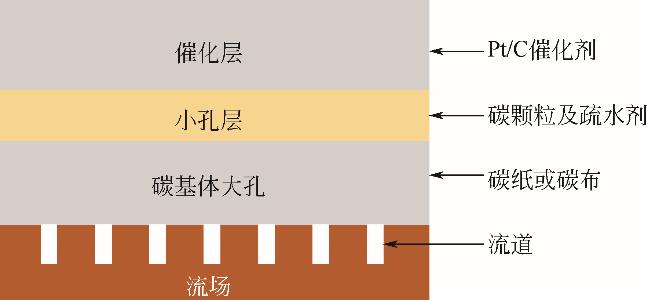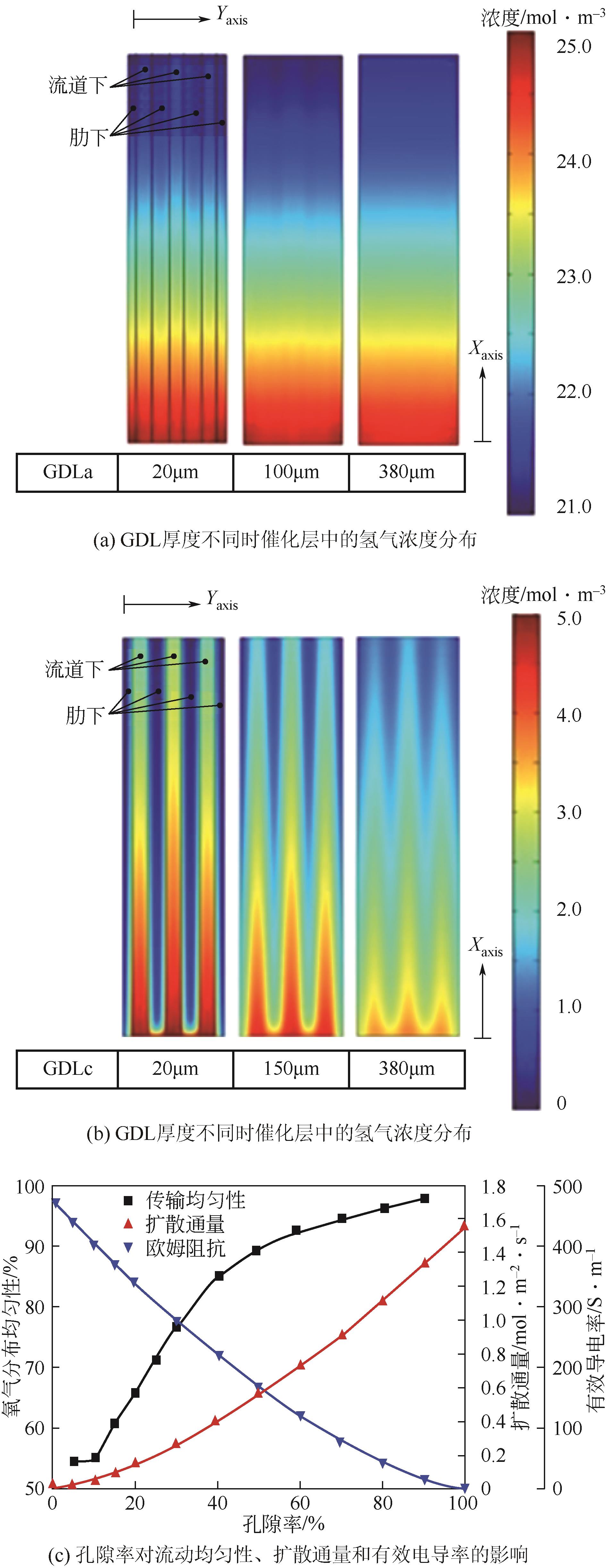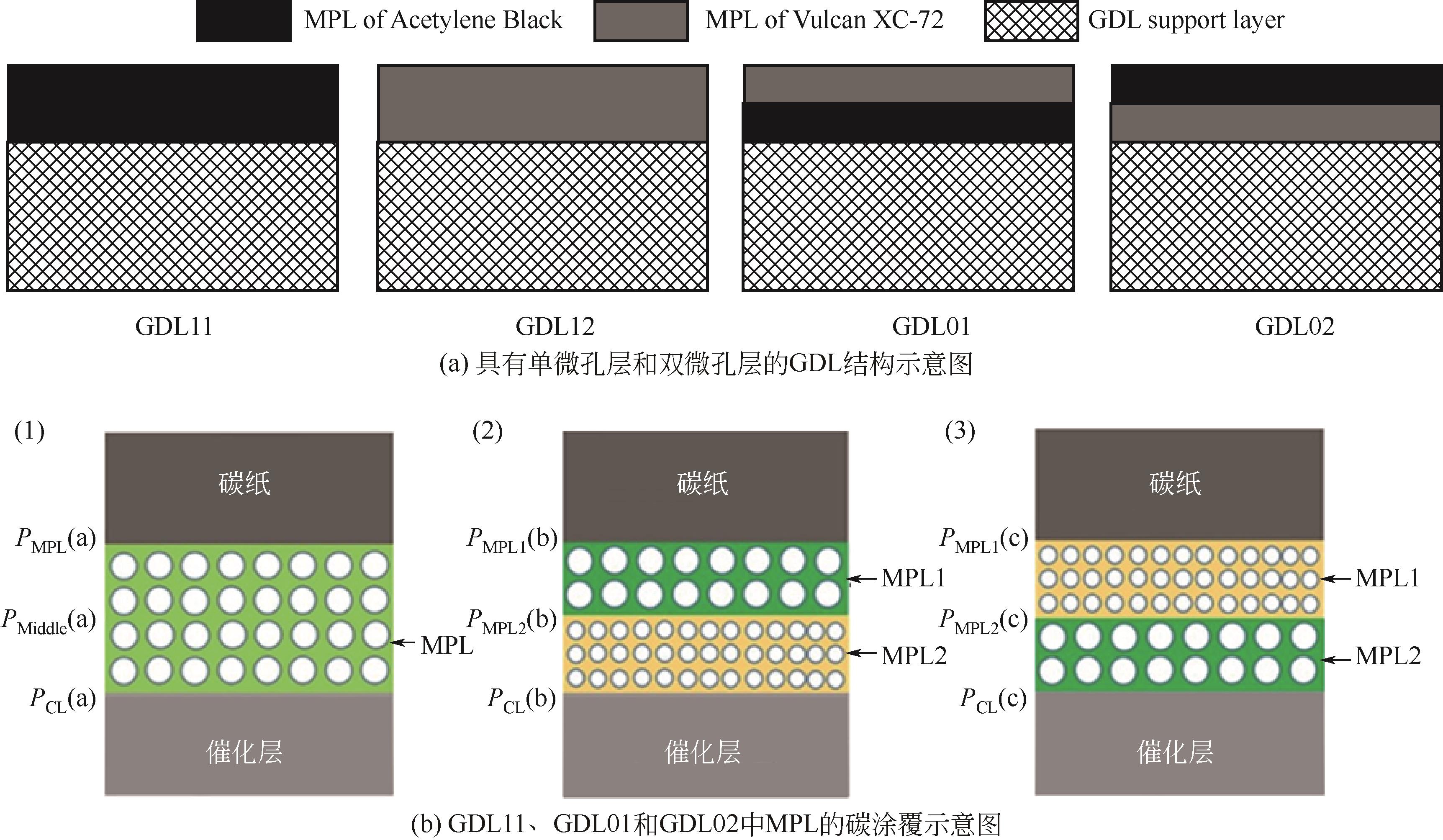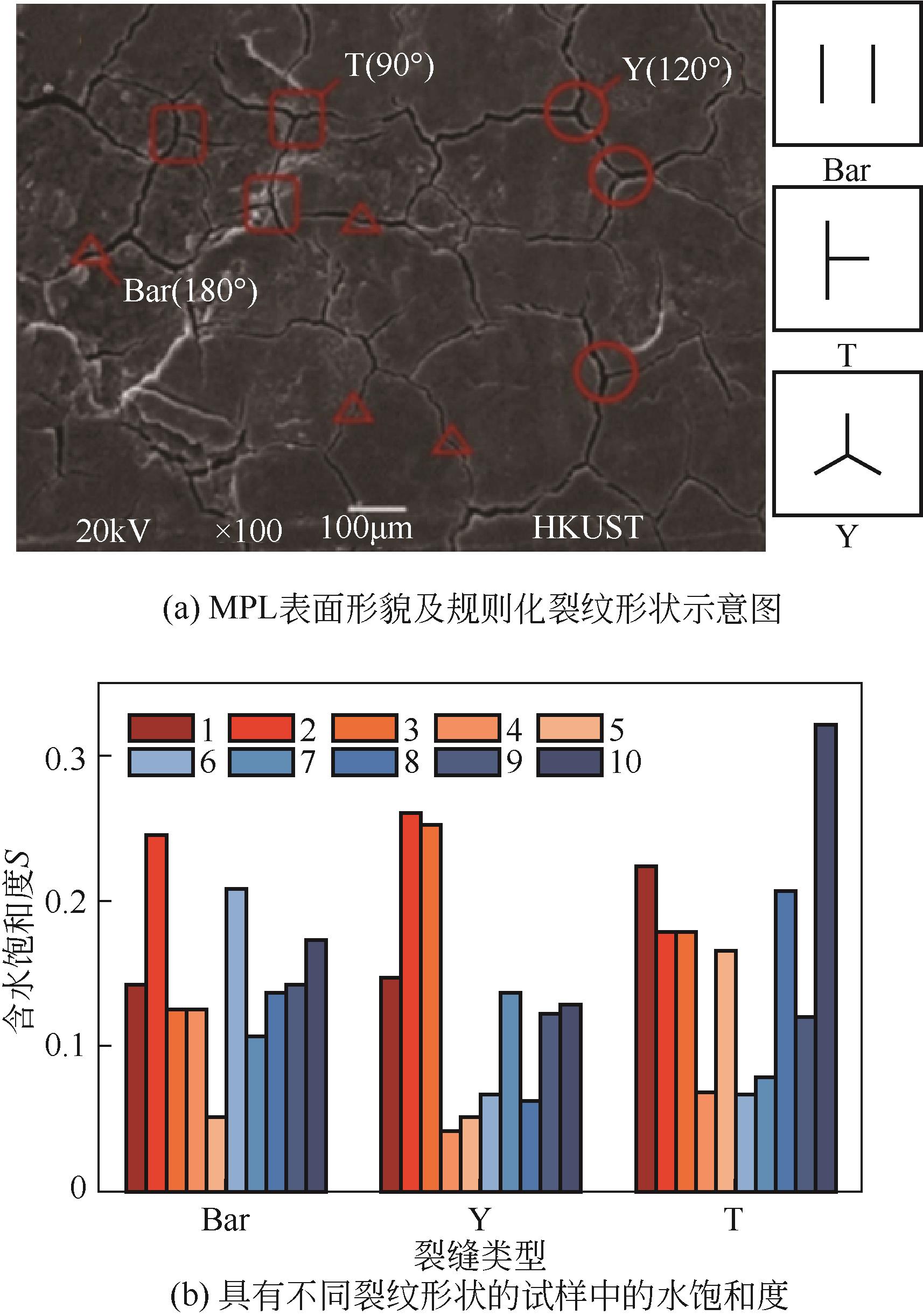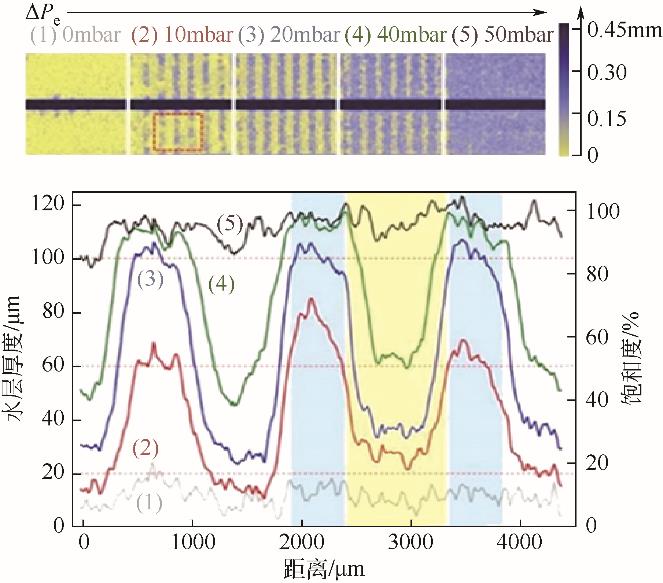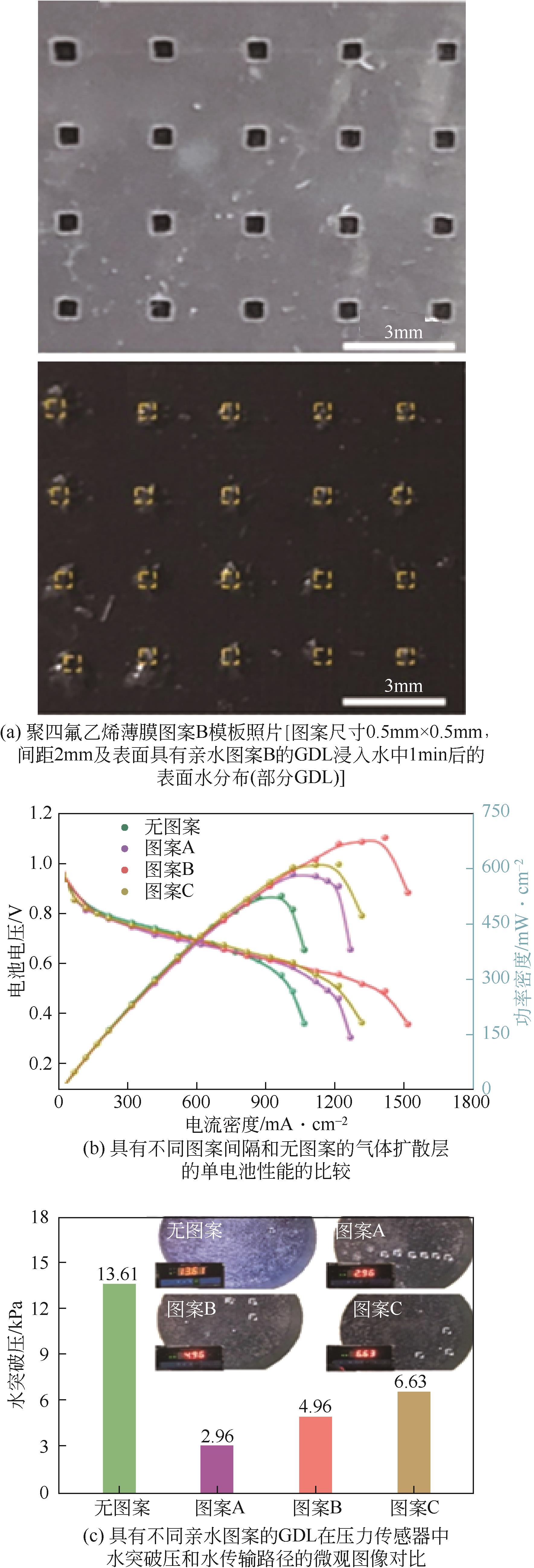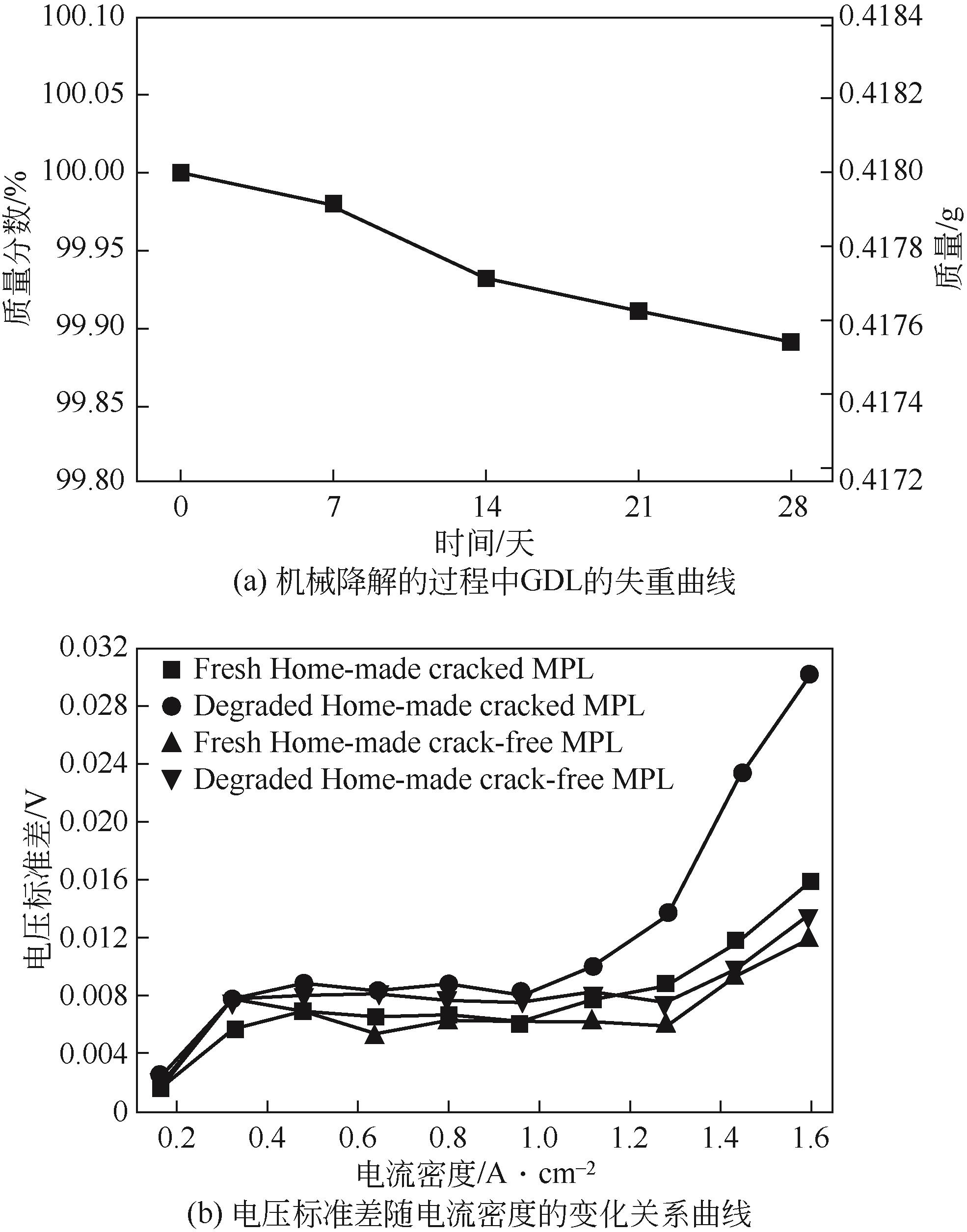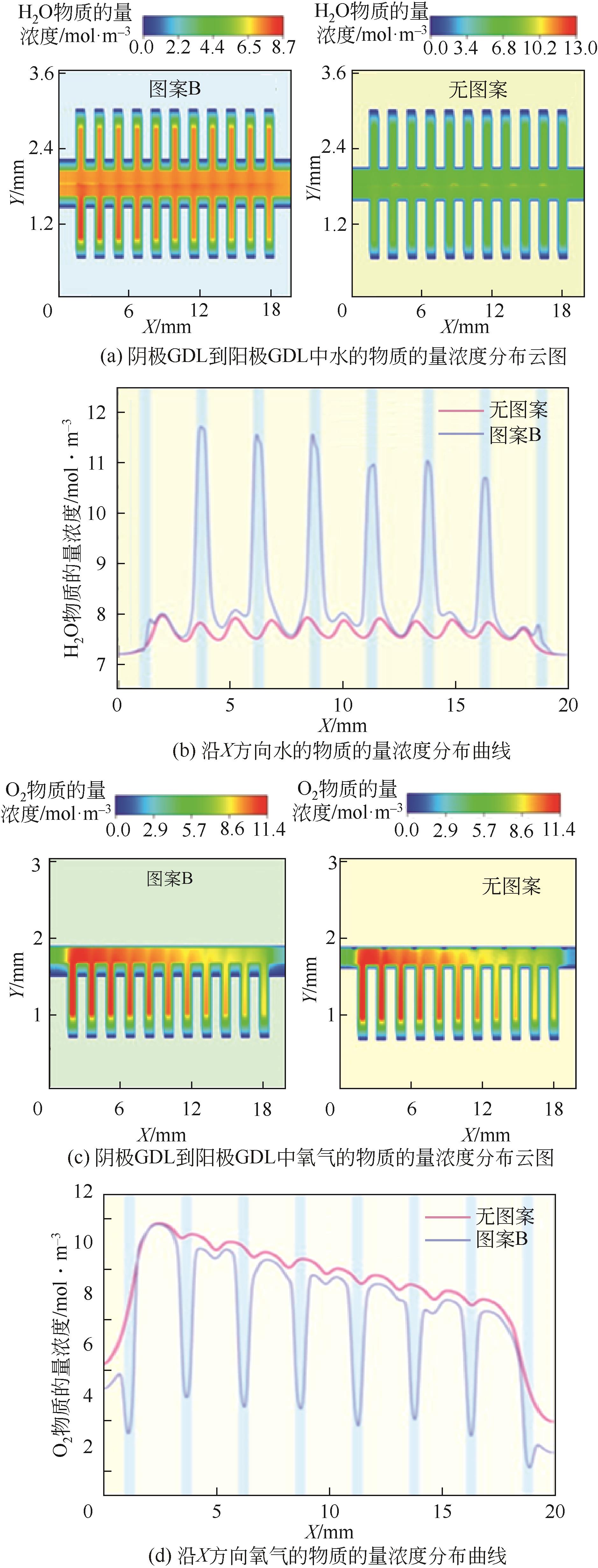Chemical Industry and Engineering Progress ›› 2023, Vol. 42 ›› Issue (S1): 246-259.DOI: 10.16085/j.issn.1000-6613.2023-1102
• Energy processes and technology • Previous Articles Next Articles
Structure design of gas diffusion layer in proton exchange membrane fuel cell
CHEN Kuangyin1( ), LI Ruilan1, TONG Yang2(
), LI Ruilan1, TONG Yang2( ), SHEN Jianhua1(
), SHEN Jianhua1( )
)
- 1.School of Materials Science and Engineering, East China University of Science and Technology, Shanghai 200237, China
2.High Technology Research and Development Center,Ministry of Science and Technology of the People's Republic of China,Beijing 100044,China
-
Received:2023-07-03Revised:2023-09-26Online:2023-11-30Published:2023-10-25 -
Contact:TONG Yang, SHEN Jianhua
质子交换膜燃料电池气体扩散层结构与设计研究进展
- 1.华东理工大学材料学院,上海 200237
2.中华人民共和国科学技术部高技术研究发展中心,北京 100044
-
通讯作者:童杨,沈建华 -
作者简介:陈匡胤(2000—),女,硕士研究生,研究方向为纳米材料。E-mail:Y82210332@mail.ecust.edu.cn。 -
基金资助:国家自然科学基金(21978087)
CLC Number:
Cite this article
CHEN Kuangyin, LI Ruilan, TONG Yang, SHEN Jianhua. Structure design of gas diffusion layer in proton exchange membrane fuel cell[J]. Chemical Industry and Engineering Progress, 2023, 42(S1): 246-259.
陈匡胤, 李蕊兰, 童杨, 沈建华. 质子交换膜燃料电池气体扩散层结构与设计研究进展[J]. 化工进展, 2023, 42(S1): 246-259.
share this article
Add to citation manager EndNote|Ris|BibTeX
URL: https://hgjz.cip.com.cn/EN/10.16085/j.issn.1000-6613.2023-1102
| 63 | HUANG Xiang, HE Yinwu, ZHOU Wei, et al. Pore network modeling of fibrous porous media of uniform and gradient porosity[J]. Powder Technology, 2019, 343: 350-361. |
| 64 | NIU Zhiqiang, BAO Zhiming, WU Jingtian, et al. Two-phase flow in the mixed-wettability gas diffusion layer of proton exchange membrane fuel cells[J]. Applied Energy, 2018, 232: 443-450. |
| 65 | PARK Jae Wan, JIAO Kui, LI Xianguo. Numerical investigations on liquid water removal from the porous gas diffusion layer by reactant flow[J]. Applied Energy, 2010, 87(7): 2180-2186. |
| 66 | WANG C Y, CHENG P. A multiphase mixture model for multiphase, multicomponent transport in capillary porous media—Ⅰ. Model development[J]. International Journal of Heat and Mass Transfer, 1996, 39(17): 3607-3618. |
| 67 | CHENG P, WANG C Y. A multiphase mixture model for multiphase, multicomponent transport in capillary porous media—Ⅱ. Numerical simulation of the transport of organic compounds in the subsurface[J]. International Journal of Heat and Mass Transfer, 1996, 39(17): 3619-3632. |
| 68 | HE Wensheng, YI Jung S, VAN NGUYEN Trung. Two-phase flow model of the cathode of PEM fuel cells using interdigitated flow fields[J]. AIChE Journal, 2000, 46(10): 2053-2064. |
| 69 | NATARAJAN Dilip, VAN NGUYEN Trung. Three-dimensional effects of liquid water flooding in the cathode of a PEM fuel cell[J]. Journal of Power Sources, 2003, 115(1): 66-80. |
| 70 | Jin Hyun NAM, KAVIANY Massoud. Effective diffusivity and water-saturation distribution in single- and two-layer PEMFC diffusion medium[J]. International Journal of Heat and Mass Transfer, 2003, 46(24): 4595-4611. |
| 71 | WEBER Adam Z, DARLING Robert M, NEWMAN John. Modeling two-phase behavior in PEFCs[J]. Journal of the Electrochemical Society, 2004, 151(10): A1715. |
| 72 | NATARAJAN Dilip, VAN NGUYEN Trung. A two-dimensional, two-phase, multicomponent, transient model for the cathode of a proton exchange membrane fuel cell using conventional gas distributors[J]. Journal of the Electrochemical Society, 2001, 148(12): A1324. |
| 73 | SIEGEL N P, ELLIS M W, NELSON D J, et al. A two-dimensional computational model of a PEMFC with liquid water transport[J]. Journal of Power Sources, 2004, 128(2): 173-184. |
| 74 | MUKHERJEE Partha P, KANG Qinjun, WANG Chaoyang. Pore-scale modeling of two-phase transport in polymer electrolyte fuel cells—Progress and perspective[J]. Energy & Environmental Science, 2011, 4(2): 346-369. |
| 1 | ILBEYGI Hamid, GHASEMI Mostafa, EMADZADEH D, et al. Power generation and wastewater treatment using a novel SPEEK nanocomposite membrane in a dual chamber microbial fuel cell[J]. International Journal of Hydrogen Energy, 2015, 40(1): 477-487. |
| 2 | LIU Jiao, YU Haiyang, ZHANG Tianheng, et al. Honeycomb-like self-supported Co-N-C catalysts with an ultrastable structure: Highly efficient electrocatalysts toward oxygen reduction reaction in alkaline and acidic solutions[J]. ACS Applied Energy Materials, 2021, 4(3): 2522-2530. |
| 3 | ZHU Mengzhao, ZHAO Chao, LIU Xiaokang, et al. Single atomic cerium sites with a high coordination number for efficient oxygen reduction in proton-exchange membrane fuel cells[J]. ACS Catalysis, 2021, 11(7): 3923-3929. |
| 4 | ABDELKAREEM Mohammad ALI, ELSAID Khaled, WILBERFORCE Tabbi, et al. Environmental aspects of fuel cells: A review[J]. Science of the Total Environment, 2021, 752: 141803. |
| 5 | ELWAN Hosni Ahmed, MAMLOUK Mohamed, SCOTT Keith. A review of proton exchange membranes based on protic ionic liquid/polymer blends for polymer electrolyte membrane fuel cells[J]. Journal of Power Sources, 2021, 484: 229197. |
| 6 | LUCIANI Sara, TONOLI Andrea. Control strategy assessment for improving PEM fuel cell system efficiency in fuel cell hybrid vehicles[J]. Energies, 2022, 15(6): 2004. |
| 7 | BELZ S. A synergetic use of hydrogen and fuel cells in human spaceflight power systems[J]. Acta Astronautica, 2016, 121: 323-331. |
| 8 | YAN Mei, LI Guotong, LI Menglin, et al. Hierarchical predictive energy management of fuel cell buses with launch control integrating traffic information[J]. Energy Conversion and Management, 2022, 256: 115397. |
| 9 | 氢云链. 中国首款量产氢轿车:长安深蓝C385[J]. 上海节能, 2022(6): 725. |
| QING Yunlian. China’s first mass-produced hydrogen car: Changan Deep Blue C385[J]. Shanghai Energy Conservation, 2022(6): 725. | |
| 10 | JIAO Kui, XUAN Jin, DU Qing, et al. Designing the next generation of proton-exchange membrane fuel cells[J]. Nature, 2021, 595(7867): 361-369. |
| 11 | JEON Dong Hyup, KIM Kwang Nam, BAEK Seung Man, et al. The effect of relative humidity of the cathode on the performance and the uniformity of PEM fuel cells[J]. International Journal of Hydrogen Energy, 2011, 36(19): 12499-12511. |
| 12 | Željko PENGA, BERGBREITER Christian, BARBIR Frano, et al. Numerical and experimental analysis of liquid water distribution in PEM fuel cells[J]. Energy Conversion and Management, 2019, 189: 167-183. |
| 13 | 杨景帅. 燃料电池用新型耐高温质子交换膜的制备与性能研究[D]. 沈阳: 东北大学, 2013. |
| YANG Jingshuai. Preparation and investigation of novel high temperature proton exchange membranes for fuel cell applications[D]. Shenyang: Northeastern University, 2013. | |
| 14 | WANG Yun, RUIZ DIAZ Daniela Fernanda, CHEN Ken S, et al. Materials, technological status, and fundamentals of PEM fuel cells—A review[J]. Materials Today, 2020, 32: 178-203. |
| 15 | XING Lei, SHI Weidong, SU Huaneng, et al. Membrane electrode assemblies for PEM fuel cells: A review of functional graded design and optimization[J]. Energy, 2019, 177: 445-464. |
| 16 | PARK Sehkyu, LEE Jong-Won, POPOV Branko N. A review of gas diffusion layer in PEM fuel cells: Materials and designs[J]. International Journal of Hydrogen Energy, 2012, 37(7): 5850-5865. |
| 17 | WU Rui, ZHU Xun, LIAO Qiang, et al. A pore network study on the role of micro-porous layer in control of liquid water distribution in gas diffusion layer[J]. International Journal of Hydrogen Energy, 2010, 35(14): 7588-7593. |
| 18 | NANADEGANI Fereshteh Salimi, LAY Ebrahim Nemati, SUNDEN Bengt. Effects of an MPL on water and thermal management in a PEMFC[J]. International Journal of Energy Research, 2019, 43(1): 274-296. |
| 19 | FISHMAN Z, BAZYLAK A. Heterogeneous through-plane porosity distributions for treated PEMFC GDLs Ⅰ. PTFE effect[J]. Journal of the Electrochemical Society, 2011, 158(8): B841. |
| 20 | OMRANI Reza, SHABANI Bahman. Gas diffusion layer modifications and treatments for improving the performance of proton exchange membrane fuel cells and electrolysers: A review[J]. International Journal of Hydrogen Energy, 2017, 42(47): 28515-28536. |
| 21 | Vikalp JHA, HARIHARAN R, KRISHNAMURTHY Balaji. A 3 dimensional numerical model to study the effect of GDL porosity on high temperature PEM fuel cells[J]. International Journal of Heat and Mass Transfer, 2020, 161: 120311. |
| 22 | XIA Lingchao, NI Meng, HE Qijiao, et al. Optimization of gas diffusion layer in high temperature PEMFC with the focuses on thickness and porosity[J]. Applied Energy, 2021, 300: 117357. |
| 23 | Prince ABRAHAM B, Kalidasa MURUGAVEL K. Influence of catalyst layer and gas diffusion layer porosity in proton exchange membrane fuel cell performance[J]. Electrochimica Acta, 2021, 389: 138793. |
| 24 | KONG Chang sun, KIM Do-Young, LEE Han-Kyu, et al. Influence of pore-size distribution of diffusion layer on mass-transport problems of proton exchange membrane fuel cells[J]. Journal of Power Sources, 2002, 108(1/2): 185-191. |
| 25 | TANG Haolin, WANG Shenlong, PAN Mu, et al. Porosity-graded micro-porous layers for polymer electrolyte membrane fuel cells[J]. Journal of Power Sources, 2007, 166(1): 41-46. |
| 26 | Donggun KO, Seungwoo DOH, PARK Hyun Sun, et al. The effect of through plane pore gradient GDL on the water distribution of PEMFC[J]. International Journal of Hydrogen Energy, 2018, 43(4): 2369-2380. |
| 27 | OKONKWO Paul C, OTOR Clement. A review of gas diffusion layer properties and water management in proton exchange membrane fuel cell system[J]. International Journal of Energy Research, 2021, 45(3): 3780-3800. |
| 28 | MASAYOSHI Yuasa, AKIKO Koga, TETSUYA Kida, et al. Structural optimization of gas diffusion electrodes loaded with LaMnO3 electrocatalysts[J]. Journal of Applied Electrochemistry, 2010, 40(3): 675-681. |
| 29 | WANG Xiaoli, ZHANG Huamin, ZHANG Jianlu, et al. A bi-functional micro-porous layer with composite carbon black for PEM fuel cells[J]. Journal of Power Sources, 2006, 162(1): 474-479. |
| 30 | CHEN Honghua, CHANG Min-Hsing. Effect of cathode microporous layer composition on proton exchange membrane fuel cell performance under different air inlet relative humidity[J]. Journal of Power Sources, 2013, 232: 306-309. |
| 31 | LIN Guangyi, LIU Shouyi, YU Boquan, et al. Preparation of graded microporous layers for enhanced water management in fuel cells[J]. Journal of Applied Polymer Science, 2020, 137(47): e49564. |
| 32 | LIN Shengyan, CHANG Min-Hsing. Effect of microporous layer composed of carbon nanotube and acetylene black on polymer electrolyte membrane fuel cell performance[J]. International Journal of Hydrogen Energy, 2015, 40(24): 7879-7885. |
| 33 | XIE Zhiyong, CHEN Guofen, YU Xiao, et al. Carbon nanotubes grown in situ on carbon paper as a microporous layer for proton exchange membrane fuel cells[J]. International Journal of Hydrogen Energy, 2015, 40(29): 8958-8965. |
| 34 | LEE J, BANERJEE R, GEORGE M G, et al. Multiwall carbon nanotube-based microporous layers for polymer electrolyte membrane fuel cells[J]. Journal of the Electrochemical Society, 2017, 164(12): F1149-F1157. |
| 35 | OWEJAN Jon P, OWEJAN Jeanette E, GU Wenbin, et al. Water transport mechanisms in PEMFC gas diffusion layers[J]. Journal of the Electrochemical Society, 2010, 157(10): B1456. |
| 36 | ZHOU Chong, GUO Lingyi, CHEN Li, et al. Pore-scale modeling of air–water two phase flow and oxygen transport in gas diffusion layer of proton exchange membrane fuel cell[J]. Energies, 2021, 14(13): 3812. |
| 37 | SHI Xin, JIAO Daokuan, BAO Zhiming, et al. Liquid transport in gas diffusion layer of proton exchange membrane fuel cells: Effects of micro-porous layer cracks[J]. International Journal of Hydrogen Energy, 2022, 47(9): 6247-6258. |
| 38 | SASABE Takashi, DEEVANHXAY Phengxay, TSUSHIMA Shohji, et al. Soft X-ray visualization of the liquid water transport within the cracks of micro porous layer in PEMFC[J]. Electrochemistry Communications, 2011, 13(6): 638-641. |
| 39 | MARKÖTTER H, MANKE I, KRÜGER P, et al. Investigation of 3D water transport paths in gas diffusion layers by combined in situ synchrotron X-ray radiography and tomography[J]. Electrochemistry Communications, 2011, 13(9): 1001-1004. |
| 40 | ALRWASHDEH S S, MARKÖTTER H, HAUßMANN J, et al. Investigation of water transport dynamics in polymer electrolyte membrane fuel cells based on high porous micro porous layers[J]. Energy, 2016, 102: 161-165. |
| 41 | YANG Tien-Fu, HSUEH Ching-Yi, CHEN Bolin, et al. Effects of fluorinated ethylene propylene contents in a novel gas diffusion layer on cell performance of a proton exchange membrane fuel cell[J]. International Journal of Energy Research, 2022, 46(2): 1553-1564. |
| 42 | BOTTINO Aldo, CAPANNELLI Gustavo, COMITE Antonio, et al. Microporous layers based on poly(vinylidene fluoride) and sulfonated poly(vinylidene fluoride)[J]. International Journal of Hydrogen Energy, 2015, 40(42): 14690-14698. |
| 43 | ZHOU Ke, LI Tianya, HAN Yufen, et al. Optimizing the hydrophobicity of GDL to improve the fuel cell performance[J]. RSC Advances, 2021, 11(4): 2010-2019. |
| 44 | LI Linbo, CHEN Jun, MOSALI Venkata Sai Sriram, et al. Hydrophobicity graded gas diffusion layer for stable electrochemical reduction of CO2 [J]. Angewandte Chemie International Edition, 2022, 61(39): e202208534. |
| 45 | FERREIRA Rui B, FALCÃO D S, OLIVEIRA V B, et al. Experimental study on the membrane electrode assembly of a proton exchange membrane fuel cell: Effects of microporous layer, membrane thickness and gas diffusion layer hydrophobic treatment[J]. Electrochimica Acta, 2017, 224: 337-345. |
| 46 | MORTAZAVI Mehdi, TAJIRI Kazuya. Effect of the PTFE content in the gas diffusion layer on water transport in polymer electrolyte fuel cells (PEFCs)[J]. Journal of Power Sources, 2014, 245: 236-244. |
| 47 | SCHWEISS R, STEEB M, WILDE P M. Mitigation of water management in PEM fuel cell cathodes by hydrophilic wicking microporous layers[J]. Fuel Cells, 2010, 10(6): 1176-1180. |
| 75 | HINEBAUGH James, FISHMAN Zachary, BAZYLAK A. Unstructured pore network modeling with heterogeneous PEMFC GDL porosity distributions[J]. Journal of the Electrochemical Society, 2010, 157(11): B1651. |
| 76 | SINHA Puneet K, WANG Chaoyang. Pore-network modeling of liquid water transport in gas diffusion layer of a polymer electrolyte fuel cell[J]. Electrochimica Acta, 2007, 52(28): 7936-7945. |
| 77 | SINHA Puneet K, MUKHERJEE Partha P, WANG Chaoyang. Impact of GDL structure and wettability on water management in polymer electrolyte fuel cells[J]. Journal of Materials Chemistry, 2007, 17(30): 3089-3103. |
| 78 | FAZELI Mohammadreza, HINEBAUGH James, BAZYLAK Aimy. Investigating inlet condition effects on PEMFC GDL liquid water transport through pore network modeling[J]. ECS Transactions, 2014, 64(3): 593-602. |
| 79 | SAKAIDA Satoshi, TABE Yutaka, CHIKAHISA Takemi. Large scale simulation of liquid water transport in a gas diffusion layer of polymer electrolyte membrane fuel cells using the lattice Boltzmann method[J]. Journal of Power Sources, 2017, 361: 133-143. |
| 80 | YANG Mingyang, JIANG Y, LIU Jinling, et al. Lattice Boltzmann method modeling and experimental study on liquid water characteristics in the gas diffusion layer of proton exchange membrane fuel cells[J]. International Journal of Hydrogen Energy, 2022, 47(18): 10366-10380. |
| 81 | RAMA Pratap, LIU Yu, CHEN Rui, et al. An X-ray tomography based lattice boltzmann simulation study on gas diffusion layers of polymer electrolyte fuel cells[J]. Journal of Fuel Cell Science and Technology, 2010, 7(3): 1. |
| 82 | RAMA P, LIU Y, CHEN R, et al. Simulation of liquid water breakthrough in a nanotomography reconstruction of a carbon paper gas-diffusion layer[J]. AIChE Journal, 2012, 58(2): 646-655. |
| 48 | KITAHARA Tatsumi, NAKAJIMA Hironori, OKAMURA Kosuke. Gas diffusion layers coated with a microporous layer containing hydrophilic carbon nanotubes for performance enhancement of polymer electrolyte fuel cells under both low and high humidity conditions[J]. Journal of Power Sources, 2015, 283: 115-124. |
| 49 | SPERNJAK Dusan, MUKUNDAN Rangachary, BORUP Rodney L, et al. Enhanced water management of polymer electrolyte fuel cells with additive-containing microporous layers[J]. ACS Applied Energy Materials, 2018, 1(11): 6006-6017. |
| 50 | KORESAWA Ryo, UTAKA Yoshio. Improvement of oxygen diffusion characteristic in gas diffusion layer with planar-distributed wettability for polymer electrolyte fuel cell[J]. Journal of Power Sources, 2014, 271: 16-24. |
| 51 | GUO Feng, YANG Xiaoling, JIANG Haibo, et al. An ultrasonic atomization spray strategy for constructing hydrophobic and hydrophilic synergistic surfaces as gas diffusion layers for proton exchange membrane fuel cells[J]. Journal of Power Sources, 2020, 451: 227784. |
| 52 | GERTEISEN D, HEILMANN T, ZIEGLER C. Enhancing liquid water transport by laser perforation of a GDL in a PEM fuel cell[J]. Journal of Power Sources, 2008, 177(2): 348-354. |
| 53 | MANAHAN M P, HATZELL M C, KUMBUR E C, et al. Laser perforated fuel cell diffusion media. Part I: Related changes in performance and water content[J]. Journal of Power Sources, 2011, 196(13): 5573-5582. |
| 54 | Antoni FORNER-CUENCA, BIESDORF Johannes, GUBLER Lorenz, et al. Engineered water highways in fuel cells: Radiation grafting of gas diffusion layers[J]. Advanced Materials, 2015, 27(41): 6317-6322. |
| 55 | UTAKA Yoshio, KORESAWA Ryo. Effect of wettability-distribution pattern of the gas diffusion layer with a microgrooved separator on polymer electrolyte fuel cell performance[J]. Journal of Power Sources, 2017, 363: 227-233. |
| 56 | ZHANG Wenhui, GUO Feng, ZHOU Yingjie, et al. Gas diffusion layer with a regular hydrophilic structure boosts the power density of proton exchange membrane fuel cells via the construction of water highways[J]. ACS Applied Materials & Interfaces, 2022, 14(15): 17578-17584. |
| 57 | HIRAMITSU Yusuke, SATO Hitoshi, KOBAYASHI Kenji, et al. Controlling gas diffusion layer oxidation by homogeneous hydrophobic coating for polymer electrolyte fuel cells[J]. Journal of Power Sources, 2011, 196(13): 5453-5469. |
| 58 | YU Shuchun, HAO Jinkai, LI Jin, et al. Effect of distribution of polytetrafluoroethylene on durability of gas diffusion backing in proton exchange membrane fuel cell[J]. Materials Research Bulletin, 2020, 122: 110684. |
| 59 | LATORRATA Saverio, GALLO STAMPINO Paola, CRISTIANI Cinzia, et al. Performance evaluation and durability enhancement of FEP-based gas diffusion media for PEM fuel cells[J]. Energies, 2017, 10(12): 2063. |
| 60 | CHUN Jeong Hwan, Dong Hyun JO, KIM Sang Gon, et al. Improvement of the mechanical durability of micro porous layer in a proton exchange membrane fuel cell by elimination of surface cracks[J]. Renewable Energy, 2012, 48: 35-41. |
| 61 | WANG Z H, WANG C Y, CHEN K S. Two-phase flow and transport in the air cathode of proton exchange membrane fuel cells[J]. Journal of Power Sources, 2001, 94(1): 40-50. |
| 62 | ZHAO Benzhong, MACMINN Christopher W, PRIMKULOV Bauyrzhan K, et al. Comprehensive comparison of pore-scale models for multiphase flow in porous media[J]. Proceedings of the National Academy of Sciences of the United States of America, 2019, 116(28): 13799-13806. |
| [1] | WANG Tai, SU Shuo, LI Shengrui, MA Xiaolong, LIU Chuntao. Dynamic behavior of single bubble attached to the solid wall in the AC electric field [J]. Chemical Industry and Engineering Progress, 2023, 42(S1): 133-141. |
| [2] | SHENG Weiwu, CHENG Yongpan, CHEN Qiang, LI Xiaoting, WEI Jia, LI Linge, CHEN Xianfeng. Operating condition analysis of the microbubble and microdroplet dual-enhanced desulfurization reactor [J]. Chemical Industry and Engineering Progress, 2023, 42(S1): 142-147. |
| [3] | ZHAO Chen, MIAO Tianze, ZHANG Chaoyang, HONG Fangjun, WANG Dahai. Heat transfer characteristics of ethylene glycol aqueous solution in slit channel under negative pressure [J]. Chemical Industry and Engineering Progress, 2023, 42(S1): 148-157. |
| [4] | HUANG Yiping, LI Ting, ZHENG Longyun, QI Ao, CHEN Zhenglin, SHI Tianhao, ZHANG Xinyu, GUO Kai, HU Meng, NI Zeyu, LIU Hui, XIA Miao, ZHU Kai, LIU Chunjiang. Hydrodynamics and mass transfer characteristics of a three-stage internal loop airlift reactor [J]. Chemical Industry and Engineering Progress, 2023, 42(S1): 175-188. |
| [5] | YANG Hanyue, KONG Lingzhen, CHEN Jiaqing, SUN Huan, SONG Jiakai, WANG Sicheng, KONG Biao. Decarbonization performance of downflow tubular gas-liquid contactor of microbubble-type [J]. Chemical Industry and Engineering Progress, 2023, 42(S1): 197-204. |
| [6] | YANG Yudi, LI Wentao, QIAN Yongkang, HUI Junhong. Analysis of influencing factors of natural gas turbulent diffusion flame length in industrial combustion chamber [J]. Chemical Industry and Engineering Progress, 2023, 42(S1): 267-275. |
| [7] | XU Jiaheng, LI Yongsheng, LUO Chunhuan, SU Qingquan. Optimization of methanol steam reforming process [J]. Chemical Industry and Engineering Progress, 2023, 42(S1): 41-46. |
| [8] | GUO Qiang, ZHAO Wenkai, XIAO Yonghou. Numerical simulation of enhancing fluid perturbation to improve separation of dimethyl sulfide/nitrogen via pressure swing adsorption [J]. Chemical Industry and Engineering Progress, 2023, 42(S1): 64-72. |
| [9] | SHAO Boshi, TAN Hongbo. Simulation on the enhancement of cryogenic removal of volatile organic compounds by sawtooth plate [J]. Chemical Industry and Engineering Progress, 2023, 42(S1): 84-93. |
| [10] | CHEN Lin, XU Peiyuan, ZHANG Xiaohui, CHEN Jie, XU Zhenjun, CHEN Jiaxiang, MI Xiaoguang, FENG Yongchang, MEI Deqing. Investigation on the LNG mixed refrigerant flow and heat transfer characteristics in coil-wounded heat exchanger (CWHE) system [J]. Chemical Industry and Engineering Progress, 2023, 42(9): 4496-4503. |
| [11] | LIU Xuanlin, WANG Yikai, DAI Suzhou, YIN Yonggao. Analysis and optimization of decomposition reactor based on ammonium carbamate in heat pump [J]. Chemical Industry and Engineering Progress, 2023, 42(9): 4522-4530. |
| [12] | ZHAO Xi, MA Haoran, LI Ping, HUANG Ailing. Simulation analysis and optimization design of mixing performance of staggered impact micromixer [J]. Chemical Industry and Engineering Progress, 2023, 42(9): 4559-4572. |
| [13] | ZHANG Qi, ZHAO Hong, RONG Junfeng. Research progress of anti-toxicity electrocatalysts for oxygen reduction reaction in PEMFC [J]. Chemical Industry and Engineering Progress, 2023, 42(9): 4677-4691. |
| [14] | BU Zhicheng, JIAO Bo, LIN Haihua, SUN Hongyuan. Review on computational fluid dynamics (CFD) simulation and advances in pulsating heat pipes [J]. Chemical Industry and Engineering Progress, 2023, 42(8): 4167-4181. |
| [15] | LI Dong, WANG Qianqian, ZHANG Liang, LI Jun, FU Qian, ZHU Xun, LIAO Qiang. Performance of series stack of non-aqueous nano slurry thermally regenerative flow batteries [J]. Chemical Industry and Engineering Progress, 2023, 42(8): 4238-4246. |
| Viewed | ||||||
|
Full text |
|
|||||
|
Abstract |
|
|||||
